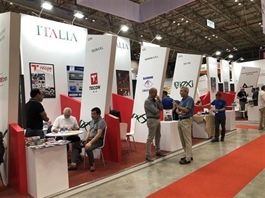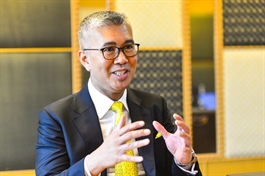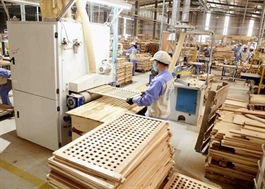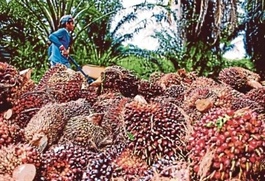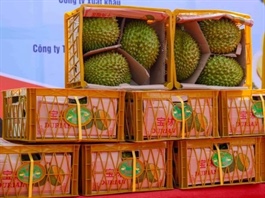Việt Nam and Russia deepen collaboration in LNG and nuclear energy
Việt Nam and Russia deepen collaboration in LNG and nuclear energy
As Việt Nam and Russia embark on ambitious liquefied natural gas (LNG) and nuclear energy projects, their partnership promises to reshape the energy landscape and strengthen bilateral ties. Russian President Vladimir Putin's recent visit to Việt Nam marks a significant step forward, heralding new opportunities for collaboration and growth in these critical sectors.

LIQUID GAS: The Thị Vải LNG terminal is based in Phũ Mỹ Town of Bà Rịa Vũng Tàu Province. Russian President Vladimir Putin recently highlighted Russia's capability to both produce LNG in Việt Nam and supply it to the country. VNA/VNS Photo |
During his trip to Việt Nam last month, Russian President Vladimir Putin highlighted Russia's capability to both produce liquefied natural gas (LNG) in Việt Nam and supply it to the country.
"There are different options here: we can take part in the construction of the appropriate liquefaction capacities, or we can supply our liquefied gas from the territory of the Russian Federation. Either way, it’s possible, there are prospects here, there are corresponding blocks where we can operate and produce liquefied natural gas," he told the media.
In his article in the Nhân Dân (The People) newspaper on June 19 titled "Russia and Việt Nam: A Friendship Tested over Time”, President Putin announced plans for the Novatek group, Russia's leading LNG producer and exporter, to implement LNG projects in Việt Nam.
“The energy sector remains a strategically important area of bilateral cooperation. The Vietsovpetro joint venture, which has been exploring deposits on Việt Nam's continental shelf for more than four decades, has proved highly efficient," Putin wrote.
"The volume of oil it has produced over the years has exceeded 250 million tonnes. Rusvietpetro, a joint venture company established in 2008, is successfully operating in Russia's Nenets Autonomous Area. It has already extracted over 35 million tonnes of oil in the harsh conditions of the Far North. Gazprom, in turn, is engaged in gas extraction in Việt Nam, while another major Russian company, Novatek, intends to implement LNG projects on Vietnamese territory.”
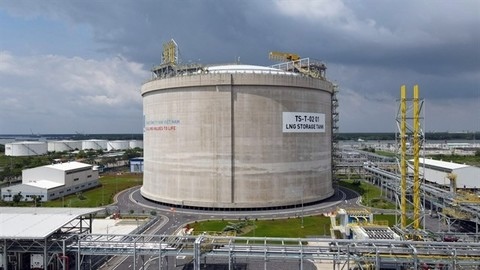
OILING THE WHEELS: President Tô Lâm and President Vladimir Putin witness the signing of a MoU on cooperation between Petrovietnam and Novatek JSC. Photo PVN |
Novatek is one of the few energy groups licensed by Russia to export LNG directly. Among the 11 cooperation documents signed between the ministries, sectors, and enterprises of the two countries during Putin's visit, one was a memorandum of cooperation in Việt Nam between the Việt Nam Oil and Gas Group and Novatek.
Earlier, Putin stated that Russia was ready to establish long-term direct supplies of hydrocarbons, including LNG, to Việt Nam, and Russian companies were ready to join large-scale projects using LNG as co-investors and suppliers.
In September 2023, Novatek CEO Leonid Mikhelson said that the company’s Vietnamese partners made a number of specific proposals to enter the republic’s market, but negotiations are complicated by the lack of a legislative framework for such projects and problems with demand.
Việt Nam’s plan for LNG
The Vietnamese government has placed liquefied natural gas (LNG) at the centre of its Power Development Plan VIII (PDP8) as a means to transition away from coal. Under PDP8, no new coal-fired plants will be developed after 2030.
The plan also imposes a deadline of June 2024 for these coal plants to proceed with their projects; otherwise, delayed or abandoned coal-fired ventures will be terminated and replaced by renewable or LNG-based power plants.
According to PDP8, Việt Nam expects to derive 25 per cent, or 37,000 MW of power, from LNG by 2030. This will require significant sector growth and investment. Domestic LNG projects currently produce just 7 billion cubic metres per year of usable gas, which is not enough to fulfil Việt Nam’s current needs.
In 2018, Việt Nam imported 55 per cent of the total LNG used domestically; by 2020, that number had grown to 70 per cent.
According to Việt Nam's gas industry development plan, the country will need to import 1 to 4 billion cubic metres of LNG per year from 2021-2025, increasing to 6 to 10 billion cubic metres per year by 2026.
Novatek’s interest
Before Putin's discussion about plans to provide long-term LNG supplies to Việt Nam, Russian media had frequently addressed this issue.
The Novatek group has shown interest in the LNG sector in Việt Nam on at least three occasions. LNG is regarded as the cleanest fossil fuel available today, as it does not produce soot, smoke, or dust during the combustion of natural gas. Furthermore, LNG-powered electricity is less dependent on natural conditions compared to wind or solar power, making it less prone to interruptions.
With these exceptional advantages, LNG has become a seismic name across continents. In the United States, El Pais reported that the appeal of LNG is akin to a modern-day gold rush, shaking energy centres to their core. Numerous LNG facilities have been constructed to meet export demands, making the US the world's largest LNG exporter in 2023.
According to a January report by Fortune, LNG terminals are proliferating along the European coastline. Last year, more than 20 new or expanded LNG terminals were planned across the European Union. These terminals are now becoming operational, resulting in an increasing influx of LNG into the EU.
In Asia, Reuters reported that LNG imports reached a record high of 26.61 million tonnes in December 2023, establishing the continent as the world's leading LNG importer.
In a July 2023 article, the Russian news agency Sputnik highlighted the LNG trend in Việt Nam. Following its first shipment of 70,000 tonnes of LNG from the multinational energy group Shell last year, Việt Nam has officially integrated into the global LNG trend.
Sputnik assessed that LNG serves as a "bridge fuel" in Việt Nam's transition from fossil fuels to cleaner energy sources. It is also considered a sensible choice given future challenges, as coal-fired power cannot be expanded (Việt Nam plans to cease using coal for electricity generation by 2050, according to PDP8), and hydropower has no further development potential. Under PDP8, Việt Nam aims to increase the share of gas-fired power from LNG to 14.9 per cent by 2030.
Việt Nam is emerging as one of Asia’s most promising markets for LNG imports for electricity generation. Nguyễn Quốc Thập, president of the Việt Nam Petroleum Association, said, “Having a mechanism to contract power output in accordance with gas volume is critical for the development of imported LNG power projects.”
Golden opportunity in VN
According to an October 2023 report by CNBC, experts have identified Việt Nam as one of the Southeast Asian countries poised to become a key driver for the LNG market by 2030. With LNG demand expected to surge in the coming years under PDP8, Việt Nam is predicted to become a standout player in the LNG market and is on track to become a major force in the sector.
"LNG demand from Europe is projected to peak in 2027 and then decline by 2030. At that point, Southeast Asia, particularly Việt Nam, Thailand and Indonesia, will drive growth," said Tony Regan, head of the Asia-Pacific gas division at NexantECA, an energy and refining consultancy.
Recognising the significant opportunity in Việt Nam, Novatek established a representative office in Hà Nội as early as August 2021, aiming to develop a range of LNG supply projects for the country.
According to Interfax, in October 2022, Leonid Mikhelson, the founder and chairman of Novatek, informed Russian media that the group was exploring the possibility of supplying LNG to both existing and newly constructed power plants in Việt Nam.
"Novatek is examining the potential to build an LNG terminal in Việt Nam," he added.
By July 2023, Novatek representatives met with Phạm Văn Phong, general director of PV GAS, expressing their desire to collaborate with the Vietnamese group on LNG trading for 2023-2026. In an official statement following the meeting, Novatek emphasised its high regard for the cooperation opportunities with PV GAS.
In March, during a meeting with Deputy Minister of Industry and Trade Nguyễn Sinh Nhật Tân, Novatek reiterated its strong interest in various LNG projects in Việt Nam. E.N. Golm, Novatek's director of Business Development, highlighted the company's keen focus on Việt Nam's liquefied natural gas sector.
This includes participation in the Cà Ná LNG power project alongside other partners, as well as tapping into the rapidly growing Vietnamese gas market. Given the positive results from President Putin's visit to Việt Nam and the subsequent announcements by the Russian leader, it is expected that Novatek will soon begin LNG projects in the country.
Nuclear research: new era of cooperation
Việt Nam and Russia are partnering to develop a Nuclear Technology Research Centre featuring a new 10MW research reactor, aiming to produce radiopharmaceuticals and irradiate silicon for semiconductor manufacturing. This was announced by Trần Chí Thành, director of the Việt Nam Atomic Energy Institute, at a press conference held by the Ministry of Science and Technology on July 4.

NUCLEAR BUTTON: Việt Nam currently operates the Đà Lạt Nuclear Reactor, which has been in service for 40 years. Photo baolamdong.vn |
Thành said that by the end of June, Alexey Likhachev, general director of the Russian State Atomic Energy Corporation (Rosatom), and Huỳnh Thành Đạt, Việt Nam's minister of Science and Technology, exchanged a memorandum regarding the implementation of the Nuclear Technology Research Centre (CNST) project in Việt Nam. Since then, the two parties have agreed on the methods of cooperation and implementation to ensure the project's effective construction and operation.
The CNST is expected to be located in Long Khánh City, Đồng Nai Province. The centre will feature a pool-type nuclear reactor with a capacity of 10MW, using low-enriched fuel manufactured by Russia. Thành said that the project had already started designing the reactor and surveying suitable locations for its construction.
The new research reactor aims to produce radiopharmaceuticals for cancer treatment and diagnosis, a critical task given that Việt Nam sees approximately 180,000 new cancer cases annually, with a domestic treatment success rate of around 40 per cent (compared to 70 per cent globally).
"Currently, the Đà Lạt Nuclear Reactor produces nearly 10 types of radiopharmaceuticals, but the new reactor could increase this capacity by five to seven times," Thành said.
The Ministry of Science and Technology has tasked the Việt Nam Atomic Energy Institute with forming specialised teams focused on reactor physics, horizontal channel design, isotope production, materials research, silicon irradiation for semiconductors, activation analysis research, environmental protection, and nuclear safety. This initiative aims to ensure a skilled research and application workforce for the new reactor’s efficient and safe operation once the CNST becomes operational.
Thành also mentioned ongoing collaborations with several international institutions, including the Joint Institute for Nuclear Research in Dubna, Russia, to provide long-term training for personnel.
At the press conference, Deputy Minister of Science and Technology Nguyễn Hoàng Giang emphasised Việt Nam's policy of developing nuclear energy for peaceful purposes alongside socioeconomic development. He highlighted the practical demand for nuclear energy, demonstrated by its applications in medicine, agriculture, and the import-export of agricultural goods.
"Aligned with global trends, many countries are refocusing their resources on nuclear energy for socioeconomic development. Thus, the project requires long-term preparation, with the goal of integrating nuclear energy into our socioeconomic growth," he said.
The Nuclear Technology Research Centre project is being executed under an intergovernmental agreement signed in 2011. The Vietnamese government approved the investment policy for the project in 2018, marking the first time Việt Nam had undertaken a large-capacity research reactor project.
Trần Hồng Thái, also deputy minister of Science and Technology, noted that the project was of great interest to both Việt Nam and Russia and had been included in the priority list for cooperation between the two governments.
"The success of the project not only marks an important milestone in Việt Nam-Russia scientific and technological cooperation, enhancing Việt Nam's nuclear energy capabilities, but it also lays the groundwork for Việt Nam and Russia to continue engaging in more significant cooperative activities in the future, particularly in nuclear energy," Thái said.
To support the feasibility study, safety analysis, and design dossier review, the Ministry of Science and Technology has requested Rosatom to facilitate the involvement of Vietnamese experts in the basic design of the reactor and the accompanying safety calculations and analyses. Rosatom will also assist Việt Nam in training personnel to operate the reactor.
Việt Nam currently operates the Đà Lạt Nuclear Reactor, which has been in service for 40 years. Originally built by the United States in 1963 as the TRIGA Mark-2 reactor with a capacity of 250kW, the reactor was decommissioned before April 1975, with all fuel rods removed and returned to the US.
In 1982, the Soviet Union assisted in restoring and upgrading the Đà Lạt Nuclear Reactor, which was recommissioned in March 1984 with a nominal capacity of 500kW, double that of the original TRIGA reactor.
The reactor is used for scientific research, sample analysis, radiopharmaceutical production for healthcare and industry, and personnel training.




